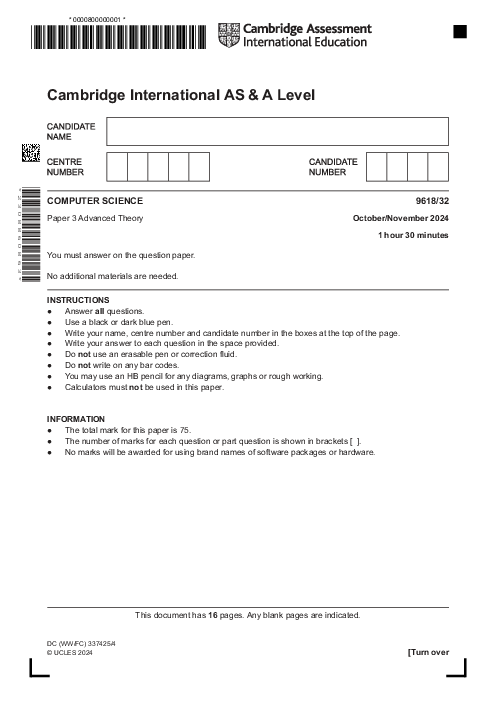Computer Science 9618,32 Oct Nov 2024
Laura Bellini
1. Networking & Packet Switching | Explanation of packet switching, benefits (efficiency, fault tolerance), drawbacks (latency, packet loss), and real-world applications.
2. File Organization & Data Storage | Serial file organization characteristics, suitable use cases, and practical implementation in data management.
3. Data Structures & Pseudocode | Defining records for structured data storage, implementing a `Record` type for an order system with fields like account number, order number, and date.
4. Floating-Point Representation & Computation | Conversion of binary floating-point to decimal, normalizing values using 12-bit mantissa and 4-bit exponent, and handling two’s complement representation.
5. TCP/IP Protocols & Application Layer | Explanation of protocols like HTTP, FTP, SMTP, and their role in network communication and data transmission.
6. Boolean Algebra & Logic Minimization | Derivation of a sum-of-products Boolean expression from a truth table, Karnaugh Map (K-map) simplifications, and optimized logic circuit design.
7. Syntax & Formal Language Representation | Use of Backus-Naur Form (BNF) and syntax diagrams to define valid structures for symbols, numbers, and structured codes.
8. CISC Processor Features | Characteristics of Complex Instruction Set Computing (CISC) processors, including instruction complexity, addressing modes, and hardware efficiency.
9. Operating System Functions | Kernel role in interrupt handling, multi-tasking implementation through process scheduling, and efficient resource allocation.
10. Object-Oriented Programming (OOP) Principles | Class structures, differences between objects and classes, encapsulation, inheritance, and polymorphism in software development.
11. Binary Tree Representation & Linked Lists | Construction of a binary tree using linked lists, storing nodes in a 2D array, and implementing search functions with pointer navigation.
12. Algorithm Design & Search Implementation | Writing efficient search algorithms for linked lists using iterative approaches, managing null pointers, and returning valid node indices.
See More Paper 3 10 months ago
Computer Science (9618) Subject directory
All resources in one place
Related Past Papers
Related Tutorials
Crash report
